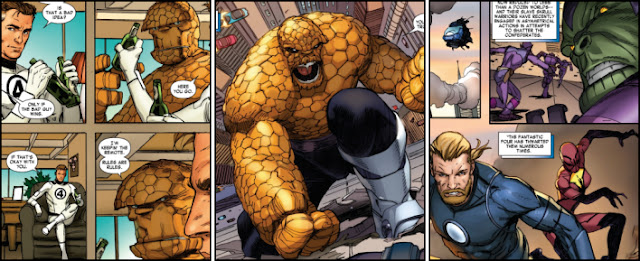 |
| WHAT IF...? DARK: VENOM No. 1, October 2023 |
In fact, such is Stephanie Phillip’s portrayal of Reed Richards as the very worst kind of self-opinionated, holier-than-thou scientist – who at one point quite literally cuts his wife’s sound protestations short with a terse command - that a fair few bibliophiles may well have disconcertingly felt that Mister Fantastic receives his ‘just deserts’ in the murderous maw of Curt Conner’s ferocious alter-ego when artist Jethro Morales prodigiously pencils the large reptile bloodily biting off his head.
Disappointingly though, the actual storyline leading up to the death of the Fantastic Four’s ordinarily super-supple leader is somewhat head-scratching, courtesy of the author turning Grimm into a strangely disagreeable dullard. Of course, many within this book’s audience will doubtless point to the Yancy Streeter’s desperate desire to look human again as being one of the protagonist’s main drives. Yet so experienced an inter-dimensional traveller would surely never simply release the deadly Venom symbiotic simply because it pitifully taps on its glass container when he approaches it..?
To further compound the problem however, the writer would then also have any looker believe that Ben would subsequently turn to the Lizard for help in retaining his new-found good looks in an underground sewer-based scientific facility, and simply allow one of Peter Parker’s most prominent arch-villain’s to surreptitiously snatch the sentient alien from him. This entire scene sadly smacks of Phillip’s just wanting to replicate a similar situation seen in Tim Story’s 2005 “Fantastic Four” movie where the Thing, housed inside a giant glass chamber, desperately needs to revert to his ‘monster self’ before the antagonist defeats both Invisible Woman and her husband, and resultantly begs the question as to just why she didn’t pen for Connors to become Venom in the first place..?
 |
| Writer: Stephanie Phillips, Artist: Jethro Morales, and Colorist: Israel Silva |


































